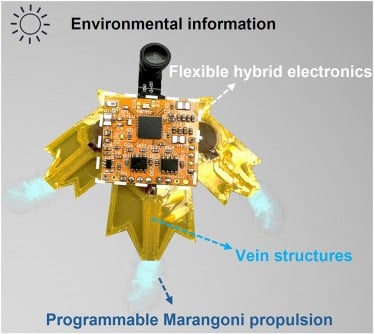Top Stories
Revolutionary S-Aquabots Unveiled for Silent Environmental Monitoring

BREAKING: Researchers from the University of Macau and Huazhong University of Science and Technology have just unveiled groundbreaking “S-aquabots”—small, leaf-inspired aquatic robots capable of silent, energy-efficient environmental monitoring. This innovation, powered by a unique Marangoni motor, promises to revolutionize ecological research, search and rescue operations, and pollution tracking.
These cutting-edge aquabots utilize ethanol-fueled propulsion and advanced biomimetic design to navigate water surfaces with unprecedented agility. With a runtime of 226 seconds on just 1.2 mL of ethanol, these centimeter-scale robots can cover distances of approximately 5 meters, showcasing their potential for long-term outdoor monitoring.
The study, published in eScience in May 2025, outlines how the S-aquabots leverage the Marangoni effect—similar to how certain beetles move across water—leading to fuel efficiency improvements of up to 3.5 times. Their innovative design allows for preprogrammed trajectories, including intricate maneuvers like U-turns and rotations, all while maintaining a low noise level of around 40 dB, comparable to natural environmental sounds.
“Our leaf-inspired S-aquabots demonstrate how biomimicry and advanced materials can overcome the long-standing challenges of aquatic robotics,” stated Prof. Junwen Zhong, the study’s corresponding author. “We believe this approach represents not only a technological breakthrough but also a blueprint for future designs of intelligent, adaptable, and eco-integrated robotic systems operating in diverse aquatic environments.”
These innovative robots are designed to blend seamlessly into their surroundings, allowing for unobtrusive monitoring of wildlife and ecosystems. Equipped with mini-cameras or digital sensors, they can track pollutants and monitor water quality without disturbing the natural habitat. Their ability to gather data on environmental conditions opens new avenues for scientific research and ecological protection.
Looking ahead, the integration of sustainable energy sources, such as solar cells, could further enhance the endurance and capabilities of these aquatic robots. The S-aquabots signify a critical step forward in developing versatile, adaptive, and eco-friendly solutions that support environmental preservation efforts globally.
As the world grapples with pressing ecological challenges, these advanced aquatic robots could play a pivotal role in disaster response scenarios and long-term environmental monitoring strategies. Their silent operation and camouflage capabilities make them ideal candidates for tracking pollution, gathering weather-related data, and conducting search-and-rescue missions in hard-to-reach water areas.
With the potential to reshape how we monitor and protect our aquatic environments, the S-aquabots are poised to make a significant impact on both research and practical applications in the field of environmental science. Stay tuned for more updates on this exciting technological development.
-

 Business4 days ago
Business4 days agoInvestors Eye Potential $60,000 Gains with Ozak AI Token
-

 Politics5 days ago
Politics5 days agoFormer Pastor Arrested on Human Trafficking and Indecent Charges
-

 Lifestyle5 days ago
Lifestyle5 days agoNatty from KISS OF LIFE Stuns in Micro-Shorts at Seoul Event
-

 Business5 days ago
Business5 days agoQuotient Wealth Partners Adjusts Holdings in iShares Russell 1000 ETF
-

 Politics4 days ago
Politics4 days agoSkip Bayless Critiques Travis Hunter’s Game Day Baptism
-

 Entertainment5 days ago
Entertainment5 days agoUtah Residents Face Resource Shortages Amid Ongoing Government Shutdown
-

 Business5 days ago
Business5 days agoCalifornia to Ban All Plastic Bags in Grocery Stores by 2026
-

 Entertainment5 days ago
Entertainment5 days agoPete Davidson Surprises Pregnant Girlfriend with Private Jet to Concert
-

 Science5 days ago
Science5 days agoCommunity Mourns Loss of Judith Ernst, Pioneer Educator at 81
-

 Politics5 days ago
Politics5 days agoIberia Parish Sees Surge in Marriage Licenses Issued in October
-

 Science5 days ago
Science5 days agoMIT Develops Groundbreaking 3D Brain Models for Personalized Therapies
-

 Entertainment5 days ago
Entertainment5 days agoAce Frehley, KISS Guitarist, Passes Away at 74 After Fall









